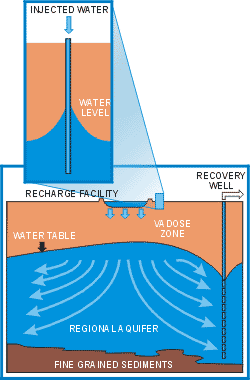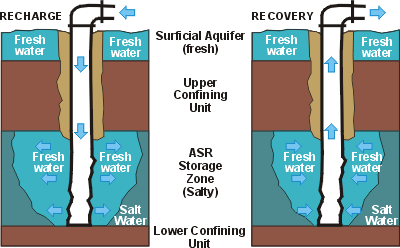 An ideal way in which to save water that might otherwise have been wasted is to store it in an aquifer underground. In this way, it can be withdrawn when needed.
An ideal way in which to save water that might otherwise have been wasted is to store it in an aquifer underground. In this way, it can be withdrawn when needed.
There are many ways in which water can be returned underground. Historically, groundwater recharge has occurred primarily from the percolation of surface water from rivers and their tributaries. As rivers begin to meander over level ground, water is constantly seeping through the riverbed into the ground. Over time, however, the riverbed can become less permeable as silt deposits increase. At this stage, it is possible to divert the river to clear the silt allowing for better penetration.
Different land uses also have an impact on the recharge of the aquifer. When a crop such as sugar cane or timber is planted, the runoff to rivers and streams will decrease as will the rate of groundwater recharge. The development of an urban area can increase the runoff which results in less groundwater recharge.
Long-term, large-scale pumping without subsequent replacement of groundwater can result in fissures and land subsidence. This results in damage to roads, railroads, pipelines, houses, dams, etc. While these are all noticeable problems that can be dealt with, the most serious and often overlooked problem of subsidence is the permanent loss of an aquifer’s storage capacity.
Artificial recharge describes the method of storing high-quality surface water in aquifers or geological formations that can receive additional water. In this way, the level of groundwater is augmented and valuable water is not lost to stream flows or evaporation.
With Aquifer Storage Recharge (ASR), water is actually directed into and stored in the ground. This is done by injecting water into the most permeable parts of the aquifer. The result is that the water is fed underground at far greater rates than would occur under natural conditions.
Aquifer Storage Recovery (ASR)
Aquifer Storage Recovery (ASR) involves collecting water (stormwater, snow melt, etc.) at a time when it is abundant and then transferring it into naturally occurring underground spaces (aquifers) that consist of porous or fractured sediments of rock. The water is stored below ground and is recovered as needed.
Most ASR systems provide seasonal water storage, storing water during the wet season and recovering it later during extended droughts. Increasingly many water managers are constructing ASR systems to ensure reliability during emergencies, whether severe floods, earthquakes, contamination incidents (see Groundwater Contamination below), pipeline breaks, or potential damage due to warfare or sabotage.
Issues to consider are that the water resource must be abundant, plus there has to be a system for collecting it. The aquifer must be able to receive and deliver water at rates that are consistent with the projected use.
Natural water quality in the storage zone ranges from fresh, suitable for drinking without treatment, to brackish, including total dissolved solids. Most sites have one or more natural water quality constituents that are unsuitable for direct potable use except following treatment. Such constituents may include elements which are typically displaced by the stored water as the bubble is formed underground.
ASR provides a cost-effective solution to many of the world’s water management needs, storing water during times of floods or when water quality is good, and recovering it later during times of drought or when water quality from the source may be poor. By storing water in underground aquifers, one reduces or eliminates the need to construct large and expensive surface reservoirs. Due to long-term over-pumping of groundwater, levels can now be restored as water is recharged.
The main driving force behind the current rapid implementation of ASR technology around the world is water supply economics. ASR systems can usually meet water management needs at less than half the capital cost of other water supply alternatives. It is also important to note that by reducing or eliminating the need for construction of dams, and by providing reliable water supplies through diversions of flood flows instead of low flows, ASR systems are usually considered to be environmentally friendly.
Water is stored deep underground in water-bearing geologic formations, or “Aquifers” that may be in sand, clayey sand, sandstone, gravel, limestone, dolomite, glacial drift, basalt and other types of geologic settings.
Most operating ASR sites are storing treated drinking water. When recovered from storage, this water usually requires only disinfection before being sent out to the water distribution system. Treated wastewater is reclaimed and piped to golf courses, parks, gardens and other areas requiring irrigation to reduce the demand for potable water.
When rains begin and irrigation demand ceases, reclaimed water is stored in ASR wells in deep brackish aquifers, from which it is recovered when needed to meet irrigation demand during dry periods.
Several sites are storing untreated groundwater pumped from overlying or underlying aquifers, or from wellfields located at great distances from the ASR site. When needed, this water is recovered from the storage zone and combined with whatever flows are then available from the primary water sources, to help meet peak or emergency water demands.
Groundwater is increasingly viewed as a desirable application of ASR technology. The newest ASR application is for storage of partially treated surface water. Stored water is recovered to help meet peak demands for supplemental untreated water, whether for urban needs, ecosystem protection, low streamflow maintenance, agricultural irrigation, industrial water requirements, power plant cooling make-up water, or other needs.
Groundwater contamination
Many developing regions suffer from either chronic shortages of freshwater or the readily accessible water resources are heavily polluted. According to the World Health Organisation (WHO), a large portion of the population in developing countries live in rural and suburban areas where conventionally treated drinking water is generally unavailable (WHO, 1993).
Accelerated population growth coupled with impoverished socioeconomic development with limited water resources and poor sanitation, leads to an increase in diseases associated with poor living conditions among which water-related and water-borne diseases play a major role. Many of the rural communities around the world get their drinking water supply from groundwater sources. The water is drawn from the boreholes and distributed to the community without any prior treatment. People from these rural communities often complain that the water tastes brackish which is normally an indication of poor quality, especially of high salinity.
Groundwater supplies have some advantages over surface water. Groundwater is generally of a more uniform character and relatively free from harmful bacteria. Groundwater can be contaminated as a result of poor solid, liquid and sanitary waste practices. Defective well construction and failure to seal abandoned wells as well as poor groundwater production management are also responsible for pollution.
Contaminated groundwater can still appear clean and yet contain pathogenic organisms; visual evaluation should therefore be avoided. Bacteria in the liquid effluents from the septic tanks and cesspools, to name a few, are likely to contaminate shallow groundwater aquifers if poorly constructed or located with respect to the production borehole. Furthermore, the presence of a shallow or perched aquifer increases the risk of contamination.

